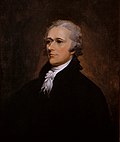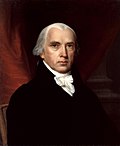Federalist Party
The Federalist Party (or Federal Party) was an American conservative political party from 1792 to 1816. The Federalists controlled the federal government until 1801. Alexander Hamilton formed the party during George Washington's first term. Hamilton built a network of supporters for his financial policies. Many supporters came from cities. These supporters grew into the Federalist Party, which wanted a fiscally sound and strong nationalistic government.
 | |
| Other name | Federalists |
| Leader | Alexander Hamilton (1789–1792) John Jay (1792–1795) John Adams (1795–1802) Charles C. Pinckney (1802–1806) DeWitt Clinton (1806–1813) Rufus King (1813–1824) |
| Preceded by | Pro-Administration party[1] |
| Succeeded by | National Republican Party |
| Headquarters | Washington D.C., U.S. |
| Essays | The Federalist Papers |
| Newspaper | Gazette of the United States[2] |
| Ideology | Hamiltonianism • Federalism • Conservatism[3][4] • Centralization[5][6] • Modernization • American School[6] • Protectionism[7] • Implied powers[8] • Pro-Jay Treaty • Nationalism[9] |
| Political position | Right-wing[10][11][12][13] |
| Religion | Congregational church[14] |
| Colors | Black and white[15]}} |
| Senate (1799) (6th U.S. Congress) | 22 / 32 |
| House (1799) (6th U.S. Congress) | 60 / 106 |
^ a: The Federalist Party appealed to businesses and to conservatives who favored a strong central government led by a vigorous executive branch, a strong commercial economy, government-controlled banks, domestic manufacturing, strong military, and in world affairs preferred friendly relationships with Great Britain in opposition to the Revolutionary French Republic. | |
Hamilton and others published a number of newspaper essays in 1787 and 1788, which are known as Federalist Papers today.
In 1789, with the start of the new government under the Constitution, President George Washington appointed his former chief of staff, Alexander Hamilton, to the office of Secretary of the Treasury. Hamilton wanted a strong national government with financial credibility.
By 1790, Hamilton started building a nationwide coalition. He and his network of treasury agents tried to link together friends of the government, especially merchants and bankers, in the new nation's dozen major cities. His attempts to manage politics in the national capital to get his plans through Congress, then, "brought strong responses across the country. In the process, what began as a capital faction soon assumed status as a national faction and then, finally, as the new Federalist party."[16]
The party opposed the War of 1812 and dwindled away after the war in 1816.
Federalist Party Media
A portrait of Alexander Hamilton by John Trumbull, 1806
President Thomas Jefferson (1801–1809)
President James Madison (1809–1817)
The Apotheosis of Washington as seen looking up from the Capitol rotunda in Washington, D.C.
References
- ↑ Chambers, William Nisbet, ed. (1972). The First Party System.
- ↑ Lora, Ronald (1999). The Conservative Press in Eighteenth-and Nineteenth-century America. Greenwood Publishing Group. p. 108. ISBN 0-313-31043-2.
- ↑ Viereck, Peter (1956, 2006). Conservative Thinkers: From John Adams to Winston Churchill. New Brunswick, NJ: Transaction Publishers. pp. 87–95.
- ↑ Diggins, John P. (1994). Up from Communism. Columbia University Press. p. 390. ISBN 9780231084895.
- ↑ The Federalists were supporters of the Federal Government and thus for a strong central government.
- ↑ 6.0 6.1 Lind, Michael (1997). Hamilton's Republic. Free Press, Simon & Schuster. ISBN 0-684-83160-0.
- ↑ Northrup, Cynthia Clark Northrup (2003). Encyclopedia of Tariffs and Trade in U.S. History: The Encyclopedia, volume I. Chapters.indigo.ca. Greenwood Publishing Group. ISBN 9780313319433. Retrieved March 15, 2019.
- ↑ They implied powers into the united states.......Against the Constitutionality of the Bank of the United States, Thomas Jefferson.
- ↑ Magness, Phillip (2017). "Alexander Hamilton as Immigrant: Musical Mythology Meets Federalist Reality" (PDF). The Independent Review. 21 (4): 497–508, at 500.
- ↑ Lipset, Seymour Martin (1960). Political man: the social bases of politics. New York City, NY: Doubleday & Company. p. 34.
- ↑ Hushaw, C. William (1964). Liberalism Vs. Conservatism; Liberty Vs. Authority. Dubuque, IA: W. C. Brown Book Company. p. 32.
- ↑ Ornstein, Allan (March 9, 2007). Class Counts: Education, Inequality, and the Shrinking Middle Class. Rowman & Littlefield Publishers. ISBN 9780742573727 – via Google Books.
- ↑ Larson, Edward J. (2007). A Magnificent Catastrophe: The Tumultuous Election of 1800, America's First Presidential Campaign. Simon and Schuster. p. 21. ISBN 9780743293174.
The divisions between Adams and Jefferson were exasperated by the more extreme views expressed by some of their partisans, particularly the High Federalists led by Hamilton on what was becoming known as the political right, and the democratic wing of the Republican Party on the left, associated with New York Governor George Clinton and Pennsylvania legislator Albert Gallatin, among others.
- ↑ Olds, Kelly (1994). "Privatizing the Church: Disestablishment in Connecticut and Massachusetts". Journal of Political Economy. 102 (2): 277–297. doi:10.1086/261932. JSTOR 2138662. S2CID 154259901.
- ↑ Parades and the Politics of the Street: Festive Culture in the Early American Republic. Simon P. Newman, p. 163.
- ↑ Chambers, Parties in a New Nation, pp. 39–40.
Other websites
- A New Nation Votes: American Election Returns 1787–1825 Archived 2008-07-25 at the Wayback Machine






